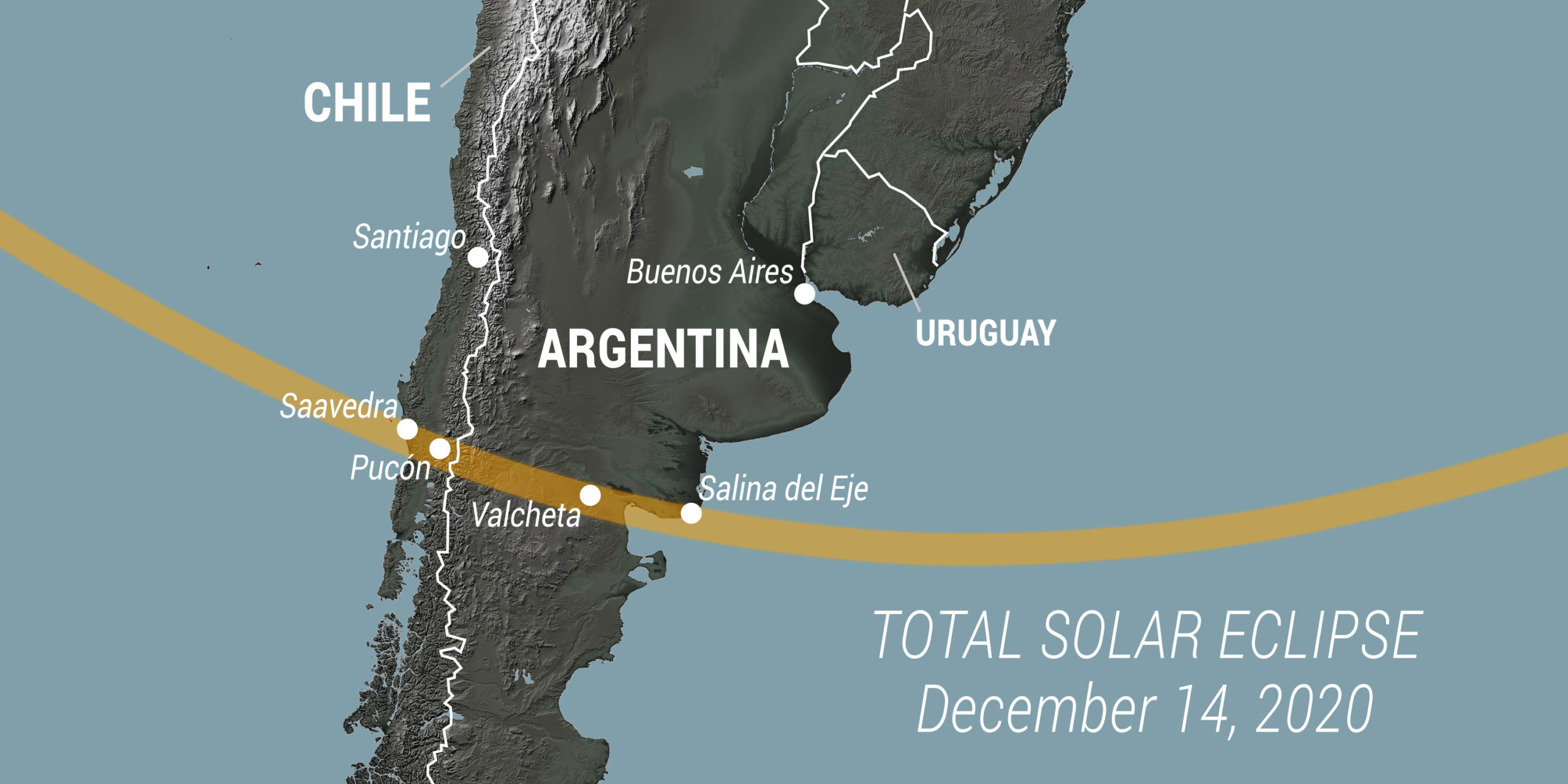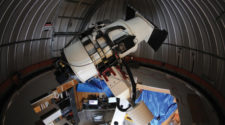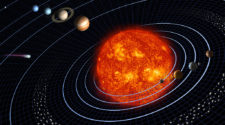DECEMBER 13, 2012: China’s Chang’e 2 mission encounters the Apollo-type asteroid (4179) Toutatis, coming to within 3.2 km of the asteroid. Chang’e 2 and other missions to the solar system’s “small bodies” are discussed in a previous “Special Topics” presentation.
DECEMBER 14, 1807: A meteorite falls to the ground near Weston, Connecticut. An ordinary chondrite, the Weston meteorite is the first documented meteorite fall in the U.S.
DECEMBER 14, 2009: NASA’s Wide-field Infrared Survey Explorer (WISE) spacecraft is launched from Vandenberg Air Force Base, California. WISE has surveyed the entire sky in infrared wavelengths and discovered numerous comets and asteroids, including the first (and only) known “Earth Trojan” asteroid, 2010 TK7, and the recent borderline-“Great” comet, Comet NEOWISE C/2020 F3. Trojan asteroids are the subject of a previous “Special Topics” presentation.
DECEMBER 14, 2020: The Geminid meteor shower, one of the strongest of the annual meteor showers with peak rates often exceeding 100 meteors per hour, will be at its peak. The peak display in 2020 coincides with new moon and thus the viewing conditions should be excellent.
DECEMBER 14, 2020: The path of a total solar eclipse will cross parts of the southern Pacific Ocean, south central Chile and Argentina, and the southern Atlantic Ocean. The longest duration of totality, slightly over two minutes, takes place in Argentina. This eclipse offers the possibility of detecting comets near the sun during totality including, potentially, the recent-discovered Comet Erasmus C/2020 S3, which will be eleven degrees from the sun. “Eclipse comets” are the subject of a previous “Special Topics” presentation.

DECEMBER 14, 2093: The Apollo-type asteroid (3200) Phaethon, the parent object of the Geminid meteors and an “active asteroid,” will pass 0.020 AU from Earth. Phaethon is discussed in last week’s “Special Topics” presentation.
DECEMBER 15, 1984: The Soviet Union’s Vega 1 mission is launched from the Baikonur Cosmodrome in present-day Kazakhstan. Vega 1 passed by Venus in June 1985 – deploying a lander and an atmospheric balloon as it did so – and then encountered Comet 1P/Halley in March 1986, returning the first images ever taken of a cometary nucleus. The return of Comet Halley in 1986 is a previous “Comet of the Week,” and the various spacecraft missions to it are discussed in that presentation.
DECEMBER 16, 1927: Carl Lampland at the Lowell Observatory in Arizona observes Comet Skjellerup-Maristany 1927k during daylight with an infrared thermocouple. This was the first infrared observation ever made of a comet.
DECEMBER 16, 2011: Comet Lovejoy C/2011 W3 passes through perihelion at a heliocentric distance of 0.006 AU. Comet Lovejoy was the first ground-discovered Kreutz sungrazer to appear during the 21st Century, and is next week’s “Comet of the Week.”
DECEMBER 16, 2017: The Apollo-type asteroid (3200) Phaethon, the parent object of the Geminid meteors, passes 0.069 AU from Earth, the closest approach it has made since its discovery in 1983 and the closest approach it will make until 2093. Phaethon is discussed in last week’s “Special Topics” presentation.
DECEMBER 16, 2018: Comet 46P/Wirtanen passes 0.077 AU from Earth, the sixth-closest cometary approach to Earth thus far during the 21st Century; during the approach it reached 4th magnitude. Close cometary approaches to Earth are the subject of a previous “Special Topics” presentation.
DECEMBER 16, 2019: The ATLAS survey in Hawaii discovers Comet ATLAS C/2019 Y1, the fourth (and most recent) discovered member of the Comet Liller “family,” which is among those discussed in this week’s “Special Topics” presentation. After passing through perihelion this past March Comet ATLAS reached a peak brightness of 8th magnitude.
DECEMBER 16, 2020: Comet 141P/Machholz 2 will pass through perihelion at a heliocentric distance of 0.808 AU. This comet has been accompanied by “companion” comets at several previous returns, being somewhat reminiscent of the disintegrated Comet 3D/Biela (a previous “Comet of the Week”). Comet 141P was recovered this past August as a very faint, stellar-appearing object and remained very faint for several months thereafter, only recently having become active. It is now bright enough for visual observations and, moreover, is accompanied by at least two “companion” comets. The viewing geometry of this return is favorable and the comet will pass 0.52 AU from Earth in mid-January 2021; additional information is available at the Comet Resource Center.
DECEMBER 18, 1680: The Great Comet of 1680 passes through perihelion at a heliocentric distance of 0.006 AU. This was one of the brightest comets of the 17th Century and from a scientific perspective one of the most important comets ever seen; it was also the first comet to be discovered by means of a telescope. It is this week’s “Comet of the Week.”
DECEMBER 18, 2004: Gordon Garradd with the Siding Spring Survey in New South Wales discovers an asteroid, which is soon found to be a re-discovery of an asteroid discovered the previous June but only observed for two nights and then “lost.” That asteroid, now known as (99942) Apophis, will be passing extremely close to Earth – within the orbital distances of geosynchronous satellites – in April 2029, and its story is told in a previous “Special Topics” presentation.
DECEMBER 18, 2018: A tiny asteroid, 10 to 14 meters in diameter, enters Earth’s atmosphere and explodes over the southwestern Bering Sea near the Kamchatka Peninsula in eastern Russia. This is the second-largest object to impact Earth during the 21st Century (behind only the Chelyabinsk meteor of February 15, 2013); these events are discussed in a previous “Special Topics” presentation.
DECEMBER 19, 1865: The French astronomer Wilhelm Tempel discovers a comet near the “bowl” of the Little Dipper, which is independently discovered in early January 1866 by Horace Tuttle in the U.S. Comet 55P/Tempel-Tuttle is the parent comet of the Leonid meteor shower, which has produced the strongest meteor showers in recorded history. This comet and the Leonids are discussed in a previous “Special Topics” presentation.
DECEMBER 19, 2022: Comet PANSTARRS C/2017 K2 will pass through perihelion at a heliocentric distance of 1.797 AU. This comet has the potential to become a conspicuous naked-eye object, possibly even a “Great Comet” (although that is unlikely), and is a previous “Comet of the Week.”
More from Week 51:
Comet of the Week Special Topic Free PDF Download Glossary
Ice and Stone 2020 Home Page


